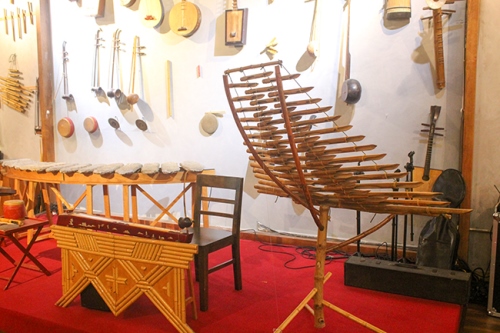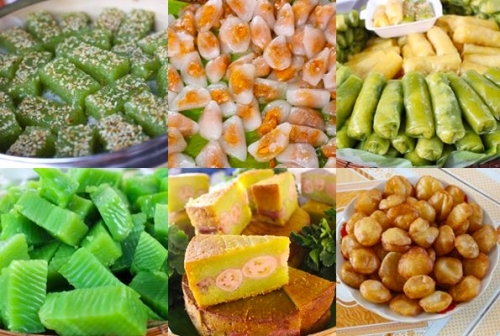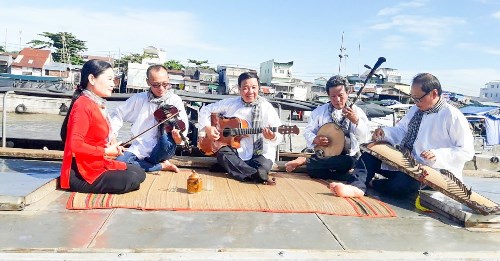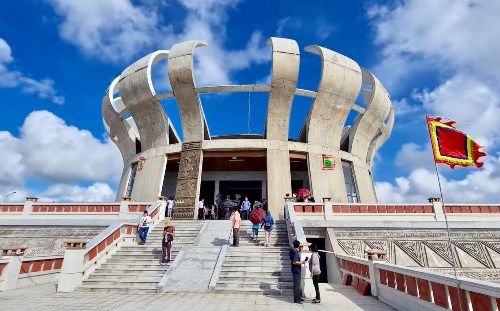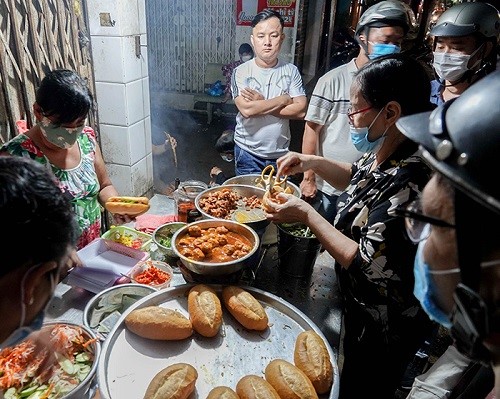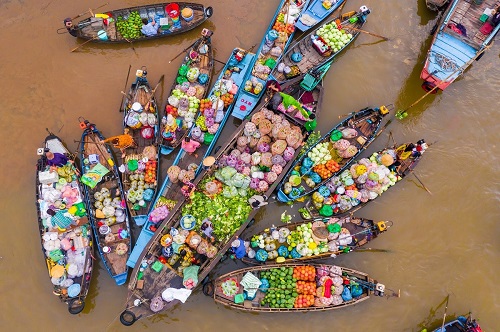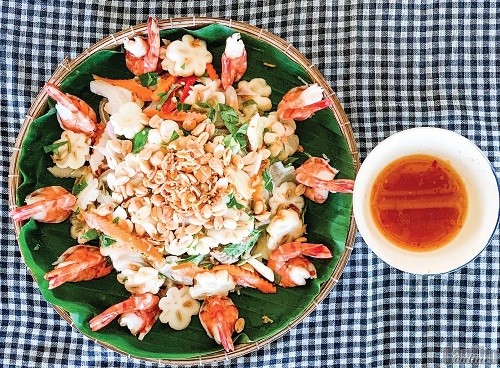
In the olden days, there were many different types of waterborne transportation vehicles. For example, to suit the deep-water river areas, there were boats made from hundreds of bamboo poles, typically following along the Tien River from the source to the Cho Thu and Cu lao Gieng areas. Many different types of boats had different shapes, and the local people added a name to identify the "hometown" of the boat, such as the Can Duoc (Long An) boat, the Can Tho boat, and the Tac Rang (Rach Gia) boat. There were also types of boats whose names did not include a location, but people still knew where they originated from, such as the Bau boat (from outside areas), the Bau Noc boat (small but with a large body and stern, from Phu Quoc and Ha Tien), the Ba la boat (from Long An, Tien Giang - Đong Thap Muoi), the Luon boat (from Bien Ho), the Chai boat (from Cho Lon), and the Be boat (from U Minh)...
Regarding travel, a book called "Gia Dinh thanh thong chi" has a passage that says: In Gia Dinh (which refers to the entire Southern region), anywhere you go you can find boats, either used as homes or to go to the market or visit relatives, or to transport rice and firewood for sale, which is very convenient, the boats are constantly traveling day and night along the river, bumping into each other, causing damage and resulting in lawsuits, with both sides blaming each other, and it's difficult to determine who's right. At that time, the director of the advisory board, Nghi Bieu Hau (or Nguyen Cu Trinh), issued an order: The boats sail regardless of whether the winds and currents are favorable or unfavorable. When boats are approaching each other, one must shout to the other "bat" (a traditional term for the boat sailing on the left is called "cay", and the one sailing on the right is called "bat") so they will go to the right, this allows the boat to easily pass by each other, avoiding a collision. If one boat has already shouted "bat" but the other boat is still sailing on the left and does not avoid a collision, the fault lies with the non-avoiding boat. In this case, if there is someone who refuses to yield, it must be determined which boat is lighter and sails with the current tide, thus having the advantage of avoiding the other boat, in this case, the non-yielding boat is at fault. With this rule in place, today, when boats want to avoid each other, they simply greet each other by calling out "bat". However, it is rare for boats to greet each other by calling out "cay". This is a definite rule for boat navigation.
The book also mentions that to resolve the issue of bandits disguising themselves as crew members on boats to rob people, Nghi Bieu Hau issued an order for all large and small boats in the area to declare their names and have their information recorded in a clear and accessible registry, this information was then carved onto the head of the boat, and anyone who violated the order would be guilty and required to keep a record of their boat. As a result, boat owners could easily identify the robbers and prosecute them. In May 1836, the governor of Nam Ky, Truong Minh Giang, submitted a proposal to the king and it was approved. The proposal is “In the past, Vinh Long and Dinh Tuong provinces had proposed in 6 provinces with many rivers, everyone had boats (…). People of those two provinces that ask for a boat to pass through the people must present to the local authorities a card marked at the top of the boat, or engraved with the title of the commune and village; again set up people to patrol the rivers and set up a post of the rear (underwater watch station) (...). Now I ask the boat heads to have different colors, for easy recognition; Gia Dinh and Bien Hoa boats in red, Vinh Long and Dinh Tuong boats in black; The boats of Tran Tay, An Giang, and Ha Tien are green, whoever smears their false identity will be guilty of a serious crime."
The records show that the road laws are based on the principle of "bat - cay," which means to move to the right side and has been understood by the Vietnamese people very early on. "Bat - cay" originally meant to speak openly or to tie in; later, it was used in boats where "bat" meant the boat and "cay" meant to paddle. It then evolved into a term that regulated avoiding each other on the river when encountering difficult situations. The boat operators also instruct each other whenever they reach a specific stretch of river, "Bat takes the bottom, cay takes the bank" (avoid the left side, avoid the right side, because one side has the bottom and one side has the bank, meaning you must go right at the middle, or be careful and cautious). Over time, movement on the river has gradually been regulated and each period has been defined into customs and then laws.
Regarding the inspection and control of domestic water transport and the establishment of docks for tax collection, preventing trade fraud and prohibited goods, relying on historical records, later generations know that the Nguyen dynasty paid attention to this issue from an early stage. According to historical records, in the year Tan Hoi (1851), Nguyen Tri Phuong, as the Nam Ky strategist, presented a regulation for interrogating at ports and monitoring transport on rivers. Boat crew members of Kinh, Thanh, Nam, Tho ethnicity, who want to trade in Cao Men, must clearly state their name, the owner of the boat, the number of people on board, the number of days they will be away, and need to have the assurance of the village head and district head. The boat will be allowed to proceed if the inspections at designated locations are accurate. If they bring prohibited or suspicious items, they will be arrested by the provincial authorities for examination. If they exceed the one-month deadline, they will temporarily be penalized, and if they exceed over one month without returning, the boat owner will be strictly punished, and if they are not seen to return after three months, all members of the crew will be held accountable and their offenses will be fully investigated.

Boats are not only a means of transportation and traveling, but also a home and a trading place for Southerners. Photosource: Duy Khoi
***
In folktales, there are many interesting stories about travel on the river in the past. One story goes that the merchant feared of "Boi," especially "Boi Ba Cum" in Cho Dem. "Boi" originally means a type of sea snail with a very beautiful shell. However, "Boi" here refers to those who steal from river boats, but always appear to be kind and friendly. For example, if a boat owner is stop for napping, these thieves would paddle up closer with ligh boat and say something to draw owner attention: they would then warn the owner to be careful, saying "there are many Boi here." The boat owner, who is surprised, would ask "Who is Boi?" The thief would then act innocently, step onto the boat and say, "Boi is here." They would then quickly steal anything that is easy to grab and paddle away. The boat owner could only watch and say, "Oh no!" without knowing what to do.
There were also robbers alongside thieves. A famous robber in the An Giang river area during the French occupation was Ba Tin, whose real name was Le Van Tin (also written as Tinh, his real name was Nguyen Van Hao, from the Cai Sao canal, Nhi My village, Cao Lanh). Some books say that he specifically robbed the wealthy to give to the poor, and the local people called him "Đon Hung Tin". Regardless of the story, robbery is still robbery and the authorities at that time eventually eliminated it.
The bandits are afraid of the patrols, but they boldly operate in the isolated headwaters area of the Hau River. However, they are very afraid of two people: Mr. Dau Quang (nicknamed Dau, with the special skill of throwing rocks) and Mr. Dao Lap (a Buddhist disciple of the Tay An Master). Folk tales say that both men have a special skill of using rocks to break the poles of the bandits' rafts (even at night, when it's as dark as ink!). There's a story that the owner of a goods raft was not at ease when he had to cross a deserted stretch of the river at night, so he asked Mr. Dau Quang to accompany him. That night, as soon as the bandits appeared from the bushes along the riverbank, the raft owner shouted in surprise: "Those people on the raft be careful, Mr. Dau Quang on the raft!" The bandits were taken aback and replied skeptically: "No way!" Then Mr. Dau Quang shouted: "Stay away from the pole!" and threw a rock that hit the pole with a "crack" and broke it in two. From then on, depending on the location, the goods rafts often borrowed the names of Mr. Dau Quang or Mr. Dao Lap to ward off the bandits.
***
The old tales show the diversity of transportation on the rivers in Southern Vietnam in terms of means, with interesting folk stories and rules that have existed for a long time - at least since the time of Nguyen Cu Trinh (1716-1767), before the French regulations over 100 years.
Source: Can Tho News - Translated by Hoang Dat





